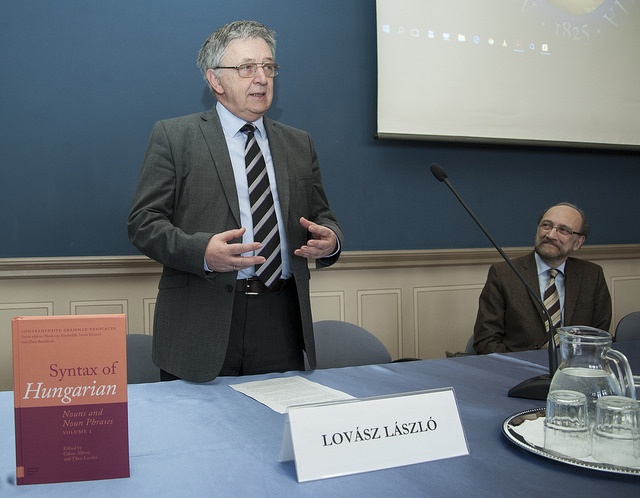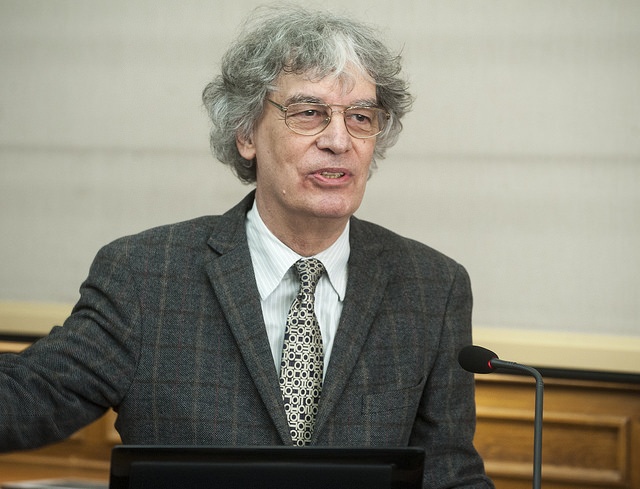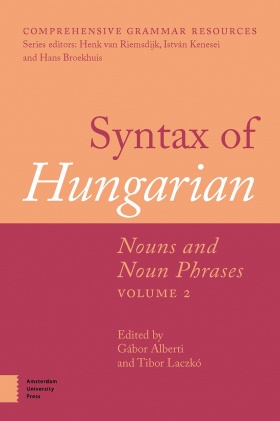English book series on the Hungarian language
The result of several decades of linguistic research of the Hungarian language is described in English for the international scientific community in a comprehensive, theory-independent book series. The first two volumes have recently been published by Amsterdam University Press. The volumes were presented in the Palace of the Academy on 30 January.
6 February, 2018
“Unlike languages spoken by many people in several countries, Hungarian, a minor language, is not only a means of communication, but also a connecting force determining national identity. Owing to this, every single event in which new linguistic results regarding Hungarian are reported on has primary importance for the Hungarian Academy of Sciences, founded to safeguard the Hungarian language,” said László Lovász, President of the Hungarian Academy of Sciences, at the book launch. He also mentioned that the volumes being presented had predecessors. Besides the significant Indo-European languages with outstanding linguistic traditions such as English, German and French, Hungarian is one of the best researched non-Indo-European languages in the world. The literature on Hungarian is comparable to that on Japanese, Chinese or Arabic, which are spoken by many more people.
 László Lovász and Gábor Prószéky, director of the Research Insitute for Linguistics of theAcademy source: mta.hu / Tamás Szigeti
László Lovász and Gábor Prószéky, director of the Research Insitute for Linguistics of theAcademy source: mta.hu / Tamás Szigeti Due to the Academy’s Open Access grant, the volumes are free to download.
The prehistory of the book series was outlined byGallery of the event academician István Kenesei, former Director of the MTA Research Institute for Linguistics, leading researcher of the Comprehensive Hungarian Grammar OTKA/NKFIH project, Co-Editor of the series Comprehensive Grammar Resources, and Editor-in-Chief of the series Syntax of Hungarian.
 István Kenesei Source: mta.hu / Tamás Szigeti
István Kenesei Source: mta.hu / Tamás Szigeti Mr. Kenesei recalled that Professor Henk van Riemsdijk, from the University of Tilburg, presented the idea for this series to him ten years ago. The series is composed of separate book series for each language. The books describe the grammatical properties of the given language in unprecedented detail. However, the whole project is theory-independent; thus, no problems of linguistic theory, syntactic rules or syntactic trees are to be found in the descriptions – rather, specific linguistic phenomena are presented.
The first series in the project described Dutch in nine volumes, and was published by Amsterdam University Press.
The publishing of the first two volumes of the Hungarian series is an outstanding international achievement of Hungarian linguistics.

The work was first supported by OTKA (Hungarian Scientific Research Fund). After OTKA ceased operating, funding was taken over by NKFIH (National Research, Development and Innovation Office). Altogether fifty experts in eight thematic groups worked in the research project between 2012 and 2016. Five Hungarian universities (the University of Debrecen (DE), Eötvös Loránd University (ELTE), Pázmány Péter Catholic University (PPKE), the University of Pécs (PTE), and the University of Szeged (SZTE)) and the MTA Research Institute for Linguistics (NYTI) cooperated in the project. Some of the researchers were employed abroad during the project, working in Austria, France, the Netherlands, Germany, Norway, Romania and the USA.
The authors aimed at creating a large-scale comprehensive description of Hungarian in English, presenting the results of several decades of research in a theory-independent manner to the international scientific community. In contrast to the Dutch series, which can be regarded as a pilot project, in which topics were arranged around the four major lexical categories (noun, verb, adjective, adverb) and the corresponding phrases, Hungarian researchers decided to establish the following eight basic topics.
- Nouns and Noun Phrases (Gábor Alberti – PTE, Tibor Laczkó – DE)
- Sentence Structure (Balázs Surányi – NYTI-PPKE)
- Postpositions and Postpositional Phrases (Katalni É. Kiss – NYTI-PPKE)
- Verb Phrases in General and Finite Verb Phrases (Károly Bibok – SZTE)
- Adjectival Phrases (Huba Bartos – NYTI-ELTE)
- Finite Embedding (Zsuzsanna Gécseg – SZTE)
- Non-finite and Semi-finite Verb Phrases (Tibor Laczkó – DE, Gábor Alberti – PTE)
- Coordination and Ellipsis (Zoltán Bánréti – NYTI)
The authors had two basic tasks. Firstly, they reviewed results published both in Hungary and abroad and summarised the findings of previous researches. Secondly, in order to bridge the gaps for a comprehensive study, missing topics were researched, and new results were incorporated into the uniform framework.
As a result of this research, besides 121 publications (scientific articles, chapters of books published elsewhere, abstracts for conferences), several thousands of pages were written on the syntax of Hungarian, in unprecedented depth and detail.
The researchers have won the Open Access grant of the Hungarian Academy of Sciences for publishing the first two volumes of the series, comprising 1,257 pages. They have won the NKFIH grant for the publishing of further volumes. In the following years, this grant ensures the volumes’ continuous review, correction, editing and publishing, both in print and online as free access documents.
